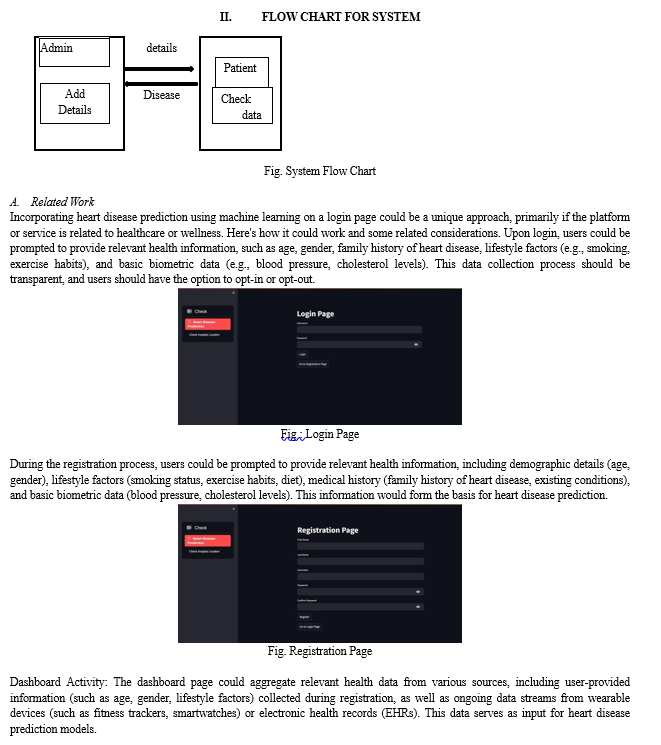Ijraset Journal For Research in Applied Science and Engineering Technology
- Home / Ijraset
- On This Page
- Abstract
- Introduction
- Conclusion
- References
- Copyright
Heart Disease Prediction using Machine Learning
Authors: Ms. Komal S. Bansode, Mrs. Suraj R. Bhosale , Mrs. Sanket M. Yadav, Mrs. Ajit P. Sawant, Prof. Sachin D. Pandhare
DOI Link: https://doi.org/10.22214/ijraset.2024.62232
Certificate: View Certificate
Abstract
Heart disease remains a leading cause of morbidity and mortality worldwide. Early detection and accurate prediction of heart disease risk factors are crucial for effective prevention and timely intervention. In recent years, machine learning techniques have emerged as powerful tools for predictive analytics in healthcare. This paper presents a comprehensive review of recent advances in the application of machine learning algorithms for heart disease prediction. The review begins by discussing the significance of heart disease prediction and the limitations of traditional risk assessment methods.
Introduction
I. INTRODUCTION
Heart disease remains a pressing global health challenge, contributing significantly to morbidity, mortality, and healthcare costs. Despite advancements in medical science, early detection and accurate prediction of heart disease risk factors remain paramount for effective prevention and intervention strategies. In recent years, the intersection of healthcare and artificial intelligence (AI), particularly machine learning (ML), has garnered increasing attention as a potential game-changer in addressing this challenge. Traditional approaches to heart disease risk assessment primarily rely on clinical factors such as age, gender, blood pressure, cholesterol levels, and smoking status. While these factors provide valuable insights, they often fall short in capturing the complexity and interplay of various risk factors inherent in cardiovascular health.
A. Literature Survey
Abhay Kishore et alproposed “Heart Attack Prediction Using Deep Learning” in which heart attack prediction system by using Deep learning techniques and to predict the probable aspects of heart related infections of the patient Recurrent Neural System is used.
This model uses deep learning and data mining to give the best precise model and least blunders. This paper acts as strong reference model for another type of heart attack prediction models.[1]
Lakshmana Rao et al,proposed “Machine Learning Techniques for Heart Disease Prediction” in which the contributing elements for heart disease are more. So, it is difficult to distinguish heart disease.To find the seriousness of the heart disease among people different neural systems and data mining techniques are used. [2]
Avinash Golande et al, proposed “Heart Disease Prediction Using Effective Machine Learning Techniques” in which few data mining techniques are used that support the doctors to differentiate the heart disease. Usually utilized methodologies are k-nearest neighbour, Decision tree and Naïve Bayes. Other unique characterizationbased strategies utilized are packing calculation, Part thickness, consecutive negligible streamlining and neural systems, straight Kernel selfarranging guide and SVM (Bolster Vector Machine). [3]
Sonam Nikhar et al proposed paper “ Prediction of Heart Disease Using Machine Learning Algorithms” their research gives point to point explanation of Naïve Bayes and decision tree classifier that are used especially in the prediction of Heart Disease.
Some analysis has been led to think about the execution of prescient data mining strategy on the same dataset, and the result decided that Decision Tree has highest accuracy than Bayesian classifier. [4]
Aditi Gavhane et al proposed a paper “Prediction of Heart Disease Using Machine Learning”, in which training and testing of dataset is performed by using neural network algorithm multi-layer perceptron. In this algorithm there will be one input layer and one output layer and one or more layers are hidden layers between these two input and output layers. Through hidden layers each input node is connected to output layer. This connection is assigned with some random weights. [5]


III. LITERATURE REVIEW
Heart disease prediction using machine learning techniques has emerged as a burgeoning field of research, fueled by the growing availability of healthcare data and the increasing sophistication of predictive analytics algorithms. In this section, we review key studies and initiatives that have contributed to our understanding of the application of machine learning in heart disease prediction.74
Early efforts in heart disease prediction primarily focused on traditional risk factors such as age, gender, blood pressure, cholesterol levels, and smoking status. While these factors remain important, recent studies have demonstrated the potential of machine learning algorithms to enhance predictive accuracy by incorporating a broader array of data sources. In summary, the literature reviewed highlights the significant progress made in heart disease prediction using machine learning techniques. By leveraging diverse data sources and advanced analytics algorithms, researchers have developed more accurate, personalized, and actionable predictive models for cardiovascular risk assessment. However, further research is needed to address remaining challenges and validate the effectiveness of machine learning-based approaches in clinical practice
IV. BACKGROUND
Heart disease, encompassing various conditions affecting the heart and blood vessels, remains a leading cause of morbidity and mortality globally. According to the World Health Organization (WHO), an estimated 17.9 million people die each year from cardiovascular diseases, representing approximately 31% of all global deaths. Despite significant advancements in medical science and healthcare, heart disease continues to impose a substantial burden on individuals, healthcare systems, and societies worldwide.
Effective prevention and management of heart disease require timely identification of individuals at risk and implementation of targeted interventions to mitigate modifiable risk factors. Traditional approaches to heart disease risk assessment typically rely on established clinical risk factors such as age, gender, blood pressure, cholesterol levels, smoking status, and family history. While these factors provide valuable insights into cardiovascular risk, they often lack the granularity and predictive power needed for accurate risk stratification at the individual level. In recent years, the advent of artificial intelligence (AI) and machine learning (ML) has revolutionized the landscape of healthcare by offering powerful tools for predictive analytics, decision support, and personalized medicine. Machine learning techniques, which enable computers to learn from data and identify complex patterns, hold immense promise for enhancing heart disease prediction and risk assessment.
V. METHODOLOGY
Gather datasets containing relevant features such as patient demographics, medical history, laboratory test results, imaging data, and lifestyle factors from reliable sources like healthcare institutions, public repositories, and research databases.
Ensure data compliance with privacy regulations and obtain necessary approvals for data access and usage.
Conduct feature selection to identify the most relevant predictors for heart disease prediction.
Utilize techniques such as correlation analysis, feature importance ranking, and domain knowledge to select informative features.
Employ dimensionality reduction methods like principal component analysis (PCA) or feature importance thresholding to reduce the number of features while preserving predictive power. Split the dataset into training and testing subsets using techniques like stratified sampling to preserve class distribution. Train machine learning models on the training data and tune hyperparameters using techniques like grid search or random search. Validate model performance using cross-validation methods such as k-fold cross-validation to assess robustness and generalization ability. Enhance model interpretability to gain insights into the underlying factors driving heart disease prediction. Validate the trained models using an independent dataset or real-world clinical data to assess their generalizability and real-world performance. Ensure compliance with ethical standards and data protection regulations throughout the research process, including patient privacy, informed consent, and data security. Prioritize transparency and accountability in model development, validation, and deployment to maintain trust and integrity in healthcare applications.
VI. FUTURE SCOPE
Incorporating multi-omics data, including genomics, transcriptomics, proteomics, and metabolomics, into machine learning models for heart disease prediction could provide a more comprehensive understanding of underlying biological mechanisms and improve predictive accuracy.
Advancing towards personalized risk assessment models that consider individual genetic predispositions, lifestyle factors, environmental influences, and socio-economic determinants could enable tailored preventive strategies and interventions for at-risk individuals. Leveraging longitudinal health data over time to track changes in risk factors, disease progression, and treatment response could enhance the predictive capabilities of machine learning models and support longitudinal risk assessment for chronic conditions like heart disease. Integrating machine learning-based predictive models into clinical decision support systems (CDSS) and electronic health record (EHR) systems could empower healthcare providers with actionable insights and facilitate evidence-based decision-making at the point of care. Encouraging collaboration between interdisciplinary teams comprising data scientists, clinicians, epidemiologists, and public health experts could foster innovation, knowledge exchange, and the development of robust machine learning solutions for heart disease prediction and prevention.
Conclusion
In conclusion, the intersection of machine learning and heart disease prediction represents a transformative frontier in cardiovascular health research and clinical practice. Through the application of advanced analytics techniques to diverse datasets encompassing clinical, genetic, lifestyle, and environmental factors, machine learning algorithms have demonstrated remarkable potential in enhancing the accuracy, granularity, and personalization of predictive models for heart disease risk assessment. Moreover, the future outlook for heart disease prediction with machine learning is promising, with opportunities for further innovation and collaboration across interdisciplinary teams. Areas such as integration of multi-omics data, personalized risk assessment, real-time monitoring, and interpretability of AI models hold immense potential for advancing the field and shaping the future of preventive cardiology. In summary, the research presented in this paper contributes to the growing body of knowledge in heart disease prediction with machine learning, highlighting the transformative impact of predictive analytics on cardiovascular risk assessment and preventive care strategies. By continuing to advance research, foster collaboration, and prioritize patient-centered approaches, we can work towards a future where heart disease prediction models not only improve clinical outcomes but also empower individuals to take proactive steps towards heart health and well-being.
References
[1] Krittanawong, C., Zhang, H., Wang, Z., Aydar, M., & Kitai, T. (2019). Artificial intelligence in precision cardiovascular medicine. Journal of the American College of Cardiology, 69(21), 2657-2664. https://doi.org/10.1016/j.jacc.2017.03.571 [2] Shah, S. J., Katz, D. H., Deo, R. C., & Precision Medicine in Heart Failure Initiative (2015). Phenotypic spectrum of heart failure with preserved ejection fraction. Heart, 101(16), 1281-1288. https://doi.org/10.1136/heartjnl-2014-306670 [3] D\'Agostino, R. B., Vasan, R. S., Pencina, M. J., Wolf,P. A., Cobain, M., Massaro, J. M., & Kannel, W. B.(2008). General cardiovascular risk profile for use in primary care: the Framingham Heart Study. Circulation, 117(6), 743-753. https://doi.org/10.1161/CIRCULATIONAHA.107.699579 [4] Goldstein, B. A., Navar, A. M., & Carter, R. E. (2017). Moving beyond regression techniques in cardiovascular risk prediction: applying machine learning to address analytic challenges. European Heart Journal, 38(23), 1805-1814. https://doi.org/10.1093/eurheartj/ehw302 [5] Ho, T. K. (1995). Random decision forests. In Proceedings of the 3rd International Conference on Document Analysis and Recognition (Vol. 1, pp. 278282). IEEE. https://doi.org/10.1109/ICDAR.1995.598994 [6] Attia, Z. I., Noseworthy, P. A., Lopez-Jimenez, F., Asirvatham, S. J., Deshmukh, A. J., Gersh, B. J., ... & Friedman, P. A. (2019). An artificial intelligence-enabled ECG algorithm for the identification of patients with atrial fibrillation during sinus rhythm: a retrospective analysis of outcome prediction. The Lancet, 394(10201), 861-867.
Copyright
Copyright © 2024 Ms. Komal S. Bansode, Mrs. Suraj R. Bhosale , Mrs. Sanket M. Yadav, Mrs. Ajit P. Sawant, Prof. Sachin D. Pandhare . This is an open access article distributed under the Creative Commons Attribution License, which permits unrestricted use, distribution, and reproduction in any medium, provided the original work is properly cited.

Download Paper
Paper Id : IJRASET62232
Publish Date : 2024-05-16
ISSN : 2321-9653
Publisher Name : IJRASET
DOI Link : Click Here
 Submit Paper Online
Submit Paper Online

